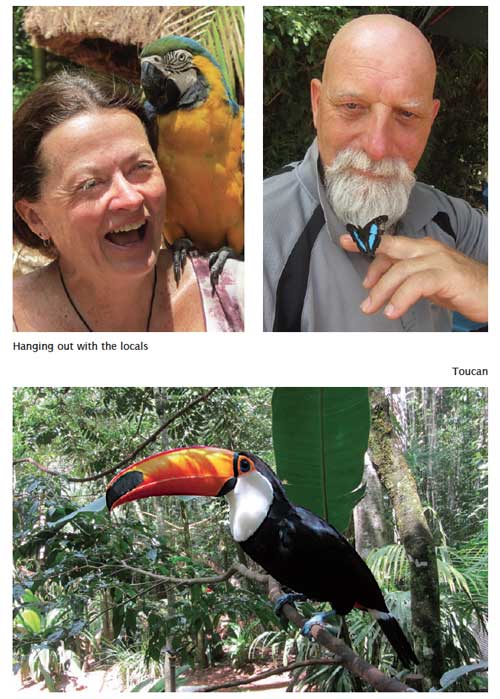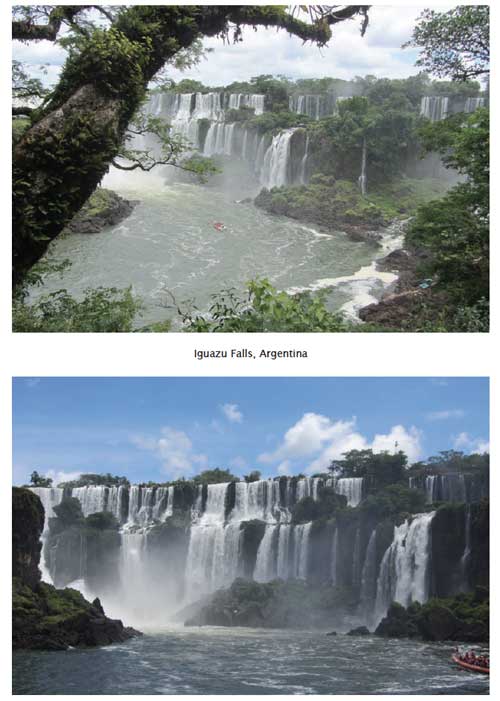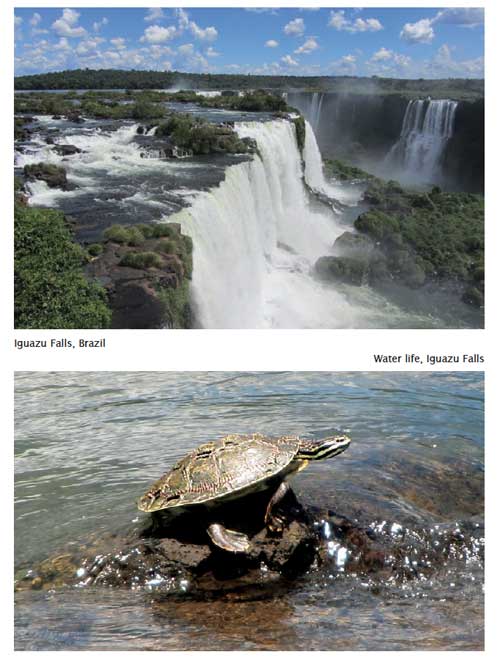
23 – 29 January 2012
Shirley: We’re heading further north to the Iguazu Falls that sit between Argentina and Brazil, a couple of days ride away. We don’t have visas for Brazil so we go back into Argentina and at Salto turn north along the Brazilian border.
The heat’s getting difficult to deal with. The temperature gauge on the bike says it’s 37.5°C before we hit the middle of the day. Some cloud cover only drops the temperature to 35°C.
I’m getting crazy with the heat. My jacket’s open to catch a little breeze, but I feel like ripping my helmet off to get some more air. It’s a scary feeling. Of course, getting my helmet off wouldn’t help anyway, the air that blasts us is hot, hot, hot. Imagine putting a hairdryer on high heat and holding it in front of your face. That’s what it’s like riding in this heat.
We stop at a service station with a parilla restaurant for lunch. I order a large bottle of mineral water and the man kindly brings us a bucket of ice too. We obviously look hot and bothered.
Cooling down, we check out the photos around the restaurant.They’re pictures of a soldier with newspaper stories about the Falklands War. We presume the soldier is the owner’s son. Signs on the wall say Malvinas son Argentina — the Malvinas are Argentina. The young man is obviously a war hero from the 1980s UK/Argentina war over the Falkland Islands, known here as Malvinas.
I’m pretty sure there’s a time difference between Uruguay and Argentina so I ask the time in my very best Spanish.
The answer comes in exceptionally good English. The man chats with us about our trip and when we leave he tells us to ‘Go with God’. We feel refreshed after cool drinks and heartened by this man’s kindness to two very hot and weary travellers.
Just when we think it couldn’t get worse, the rains come and the road is like riding on glass. We finally get to our overnight stop at Posadas, and it’s certainly nothing to write home about. A hotel with a parking garage, a restaurant that sells exceptionally cold beer served in an ice bucket, that’s all we need.
Brian: Next day it’s hot again and there’s a queue at the petrol station. Of course there is. We’re back in Argentina.
Fuelled up and heading out of town to Iguazu, we stop at the lights and the driver of the car next to us asks if it’s okay to take a photo of the bike. Sure. Next thing four camera phones appear at the windows. We feel quite the celebrities.
Riding along, the clouds begin to look ominous, from light grey, to dark and then black. With very little warning the clouds burst. It’s to be expected, I guess, as we’re very close to the Tropic of Capricorn. The rain’s bucketing down and we’re getting soaked. Riding is uncomfortable and dangerous. I can’t see much of the traffic so it stands to reason that the traffic can’t see us.
I pull off the highway into the town of Eldorado. Our little bit of gold is a closed restaurant with a large, covered outdoor eating area. I ride up onto the footpath and under the awning and we just wait it out.
The streets are awash. The gutters aren’t coping and people are wading through knee-deep water. Eventually the rain eases off and we put on our wets over our wet clothes and hit the road.
Puerto Iguazu is the gateway to the Iguazu Falls, one of the Seven Natural Wonders of the World. Our hostel has everything we need — off street parking for the bike, a pool for us and air-conditioning in the room for a good night’s sleep after our full day on the road. Perfect.
Shirley: I’m not keen on the idea of riding through Paraguay. We’ve been told it’s lawless and a risk for travellers like us. Others have told us there’s nothing to see there. Brian says it’s the quickest way to get from here to Salta in northern Argentina and then back into Chile to visit San Pedro de Atacama to see the geyser fields. He’s right, of course, and if we want to get out to Galapagos in Ecuador, time is of the essence.
To get into Paraguay we need a visa from the consulate. They don’t issue Australians with visas at the border. There’s an office of the Paraguayan government in Puerto Iguazu but they don’t issue the visas here either. To get the Paraguayan visa we need to cross the border to Foz in Brazil. To get to Brazil we need a visa. Like Paraguay, Brazil doesn’t issue visas to Australians at the border. It’s another Catch 22 moment. The good news is that the Brazilian consulate here will issue the visa. It takes 24 hours so we head there first thing.
It’s not a difficult process but it’s not straightforward either. We need to fill in the application form online and we need a bank statement. The consul staff have organised for the staff at the Bamboo Hostel next door to let travellers use their computer to access their bank and then print up a statement. They also assist with filling out the application form — all for just 30 pesos (about $5.50).
It’s an interesting sideline for the staff at the hostel and it makes the application process very simple.
Back at the Brazilian consul we hand over 161 pesos each (about $30), photos and our passports. Tomorrow we’ll have our visas for Brazil.
Now the business is done it’s time for the real reason we came here — Iguazu Falls. We opt for the bus. This means we can wear casual, cool clothes rather than bike gear. And our friends Ken and Carol from Brisbane, who’ve been travelling through South America on their motorcycle for the past three years, had their helmets stolen off their bike in the car park here some time ago. The thieves lifted the bike cover and used bolt cutters to cut the cable securing the helmets to the bike. They lost expensive helmets and their blue tooth intercom system.
•
Our first sight of the Iguazu Falls is in the distance, through some trees. Wow, wow, wow! The path winds around taking us right next to the falls. It’s madness — there are so many people here. We can’t hear each other over the roar of the falls. We can feel the spray on our faces. It’s the rainy season so the rate of water cascading over the falls is immense — they say more than 1,700 cubic metres of water per second. We just can’t believe we’re standing here at the base of the falls.


We get into a boat to actually go under the falls. We’re fitted out with life jackets and given a waterproof bag for all of our valuables. The trip into the water is incredible. It’s like they turn a fire hose on you, and you can’t keep your eyes open, the pressure is so strong. We disappear totally into the water — twice. Then we move to one of the side falls and go into the bottom of that sideways. It’s amazing. And we’re soaked. There’s not a part of us that’s not wet through: our shoes are soaked; our shorts are soaked; our tops and my watch. Some smart people put their shoes in their waterproof bag. Even smarter ones wore plastic ponchos. We’re not among them, more’s the pity. We have to dry out before we can get the bus back to town. Tomorrow we’ll come back and go to the top of the falls.
Brian: It’s Australia Day. It’s not a day we celebrate overly at home but we’re both conscious we’re a long way from Melbourne this morning. There’s no Pavlova or lamb chops for an Australia Day feast so we put homesickness behind us and head back to the falls.
A little train from the gate takes us to the walkway over the Iguazu River. The waters are calm but we can’t be far from the falls. We can hear the water roaring and see the mist rising from Garganta del Diablo — the Devil’s Throat.
When we finally see the falls words fail us. It gives us a totally different perspective. A rainbow glistens in the mist hanging over the torrent. The only drawback is the crowd pushing and shoving to get to the front to get a good look. Once they get there they’re not keen to let others in.
Manners go out the window and I get the elbows working to open a gap for Shirl to push her way through to the front. It’s hard to take it all in. These falls are massive.
We make our way back to the river, away from the madness of the falls for an ecological trip down the river in a rubber rowboat. Our multi-lingual guide, Juan, doesn’t speak English but really that isn’t a problem. The most wonderful part is just drifting along in the silence. It’s only a 35-minute ride and we wish it’d last forever.
The National Park isn’t just about the falls. There are monkeys, coatis (racoon like creatures), birds and colourful butterflies. The river waters are so clear you can see huge fish and tortoises. It’s one hell of a place.
•
Shirley: We’re going to cross into Brazil today to sort out the visas for Brian’s shortcut through Paraguay and decide to take the public bus. The backpackers at the hostel say it’s an easy trip so we give it a go, leaving the bike tucked away in the garden.
The bus stops at the Argentinean side of the border and we get our passports stamped and then hop back on the bus. It drops us at the Brazilian border. They admire our visas and stamp our passports, but the bus isn’t there when we come out of the office. Now we just have to wait for the next bus into town. What were we thinking that this seemed like a good idea?
There’s a time difference so we automatically lose an hour. Waiting for the bus I wonder if we’ll get to the consulate in time to get the visa processed today. When the bus arrives we jump on and hop off when it gets to ‘central’. It seems like the best place.
Now we’re in Foz do Iguazu, Brazil, where they speak Portuguese, with no local currency, no idea where we are or where we need to go. Top this off with the fact we don’t have a Portuguese phrase book and the stress levels begin to rise.
We try and get a cab to take us to the bank and the consulate but the cabbie directs us to the supermarket to get money. There are five ATMs but we can’t get money out of any of them. Unlike ATMs in Chile, Argentina, Uruguay and so many other countries there’s no ‘English’ option. This makes the instructions on the screen worthless.
I’m close to tears but that isn’t going to help anything. Off we walk, in search of a bank. We keep asking for directions in Spanish and eventually get to a bank where the security staff help us with the ATM. The final direction that baffled us is to re-enter your PIN to get the cash. Bloody hell — it’s so simple when you know how.
Cashed up we find a cabbie who’ll take us to the consulate for 15 Real. We don’t really know how much that is ($6.50), but we aren’t in a position to argue.
Brian: After a short ten minute cab ride we’re at the Paraguayan consular office — or so we think. We walk up a pathway where there are men sitting around smoking and drinking mate. Shirl finds a small window open and asks a man sitting at a desk if we’re in the right place. No, we’re at the back door.

We eventually find the right entrance and a lovely young lady assists us with our application. For a single entry visa we must deposit US$130 into their bank account at the bank four blocks away. Then we have to wait for the consulate staff to have their lunch before we can come back and complete the application.
To enter the banking chamber there’s a revolving bulletproof glass door with a hatch where we have to deposit anything metal. I forget I have the camera. The door won’t unlock while this piece of metal is on my person. After this little hitch we take a number and wait.
When our number is called we go into a screened off area and make the payment. It’s a lot of palaver.
Back at the consulate we have to hand over a credit card to prove we have sufficient funds. After sitting around for an hour we get the visa.
This shortcut better be worth it or I’ll never hear the end of it.
•
Negotiating the border with the motorcycle is easy. After the obligatory photo at the Argentina, Brazil and Paraguay border we head to the border post. It’s a drive-through — just like McDonalds.
Within minutes we’re riding across the bridge spanning the Iguazu River. The border is in the middle: one side is painted with the Argentinean national colours of blue and white; the other side is in the Brazilian national colours of yellow and green. Theoretically you shouldn’t stop in the no man’s land between borders but we can’t resist this majestic river and the multi-coloured bridge.
Now we’re in Brazil the only map we have is the one in the Lonely Planet guidebook. Luckily our hostel is in the same street as the Paraguayan Consulate so I manage to get there without a hiccup.
Shirley: We’re old enough to be the other hostel guests’ parents, but we’re behaving like teenagers ourselves. The heat’s beaten us and we’re going to live dangerously and change into lightweight pants and a long-sleeved T shirt to ride to the Brazilian side of the Iguazu Falls. It’s stinking hot and any thought of riding in all our protective gear takes my breath away. It’s strangely invigorating yet I feel very naughty and oh so vulnerable. I can tell Brian is taking extra care but I still feel very strange riding without all the gear.
We take a double-decker bus to the viewing points for the Iguazu Falls that are about 15 kilometres from the gate. Brian’s a little sceptical and keeps wondering aloud if this is going to be worth it after the fabulous sights on the Argentinean side of the falls.
The pathway takes us up and down steps and inclines that hug the cliffs. The views are spectacular, even better than we imagined.
You do get a completely different perspective of the falls from Brazil. Rather than the raging torrents of water, you get to see the width of these massive falls. They’re more than two kilometres wide and more than 60 metres high and made up of about 300 individual falls.
Going nuts with a camera, we walk out onto a viewing platform and are hit by the spray. We don’t rush away from this cool experience before making the trek back to the bus and the bike.
•
Back at the hostel the ‘young’ people are playing some terrible head-banging music but before we know it stops because it’s happy hour. We’re won over by the smooth-talking barman’s offer of the first drink for free — and it’s the Brazilian national cocktail, the caipirinha. It’s a refreshing and remarkably potent combination of sugarcane spirit, lime juice and sugar. Delicious!
So much like the pisco sour — one caipirinha is refreshing, two are moreish, and three are verging on lethal. Four and you’re guaranteed a heavy head in the morning.
Brian: I have to admit to a soft head this morning, as does Shirl, and we’re suffering just a little. We’re obviously tougher than the young backpackers. We’re the only ones at breakfast until one of the young girls arrives, and tells us she’s very worried about her girlfriend who lost count after 10 caipirinhas last night. She can’t get out of bed. We give some sage advice about how to deal with a hangover. It revolves around a sweet, sugary soft drink. Pity they don’t have potato cakes in Brazil.
•
The other reason to come to Foz is to visit the bird park, just near the falls. It doesn’t disappoint. It’s much cooler under the canopy of trees, wandering through habitats for some of the most exquisite and endangered bird species. We spend a pleasant afternoon watching the birds, especially the flamingos and the scarlet ibis.
There are a couple of species that are on the edge of extinction because man continues to destroy their natural forested habitat. And the bloody poachers. It beggars belief that there are people who are happy to slaughter these birds for their vivid feathers.
There’s a great saying here along the lines of ‘man needs Nature, but Nature doesn’t need man.’
•
Back at the hostel we can’t resist another caipirinha, but restrict ourselves to two. We need a good sleep for tackling Paraguay in the morning.